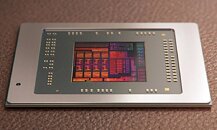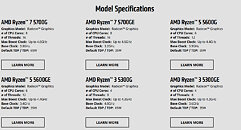Tuesday, April 13th 2021

AMD Launches Ryzen 5000G "Cezanne" APU Lineup for OEMs
AMD has today decided to launch the next generation of Accelerated Processing Units (APUs), now in form of the 5000G lineup codenamed Cezanne. The APUs are getting launched as OEM-exclusive products for now, which means that only manufacturers like Dell, HP, Lenovo, etc. can have access to them. AMD is set to announce these processors for wider masses, such as consumer DIYers, later this year. So you must be wondering what is new about the 5000G APUs. For starters, the new APUs feature AMD's improved Zen 3 core with a notable IPC boost over Zen 2 found in last generation 4000G APUs. When it comes to graphics, the new APUs feature anywhere from 6-8 GPU cores, based on the Vega architecture.
When it comes to the available models, AMD lists six SKUs, all differentiating in CPU/GPU core count, TDP, and frequency. There are three regular SKUs, with their power-efficient variants. The regular SKUs are AMD Ryzen 7 5700G, Ryzen 5 5600G, and Ryzen 3 5300G. They are normal SKUs that have a TDP of 65 Watts, meaning a higher base frequency needing a more adequate cooling solution. However, as there are regular SKUs, there are also power-efficient, TDP-constrained models present. Called the AMD Ryzen 7 5700GE, Ryzen 5 5600GE, and Ryzen 3 5300GE, these models bring the TDP down to 35 Watts and reduce base frequency by a couple of hundreds of MHz.The listed models, which you can see specifications of, are for now OEM-exclusive products. For general consumers, the announcement should follow sometimes in the coming months, so you have to wait to get these processors for a bit longer. For more information, please visit AMD's website and find greater details about them.
Source:
AMD
When it comes to the available models, AMD lists six SKUs, all differentiating in CPU/GPU core count, TDP, and frequency. There are three regular SKUs, with their power-efficient variants. The regular SKUs are AMD Ryzen 7 5700G, Ryzen 5 5600G, and Ryzen 3 5300G. They are normal SKUs that have a TDP of 65 Watts, meaning a higher base frequency needing a more adequate cooling solution. However, as there are regular SKUs, there are also power-efficient, TDP-constrained models present. Called the AMD Ryzen 7 5700GE, Ryzen 5 5600GE, and Ryzen 3 5300GE, these models bring the TDP down to 35 Watts and reduce base frequency by a couple of hundreds of MHz.The listed models, which you can see specifications of, are for now OEM-exclusive products. For general consumers, the announcement should follow sometimes in the coming months, so you have to wait to get these processors for a bit longer. For more information, please visit AMD's website and find greater details about them.


39 Comments on AMD Launches Ryzen 5000G "Cezanne" APU Lineup for OEMs
another mediocre APU
where's the RDNA APU
and most importantly, AMD already making PS5 & Serie X APUs
why not compete in the PC Market with similar offering
and APU with powerful GPU, maybe 28 - 40 CUs variants?, 6-8 cores with integrated HBM2 or GDDR6
HBM2 would make more sense because it can fit in the CPU PCB, yet more expensive
i'm for one i would gladly pay 700 $ for an APU as powerful as the Series X in the PC, AMD is leaving a huge market
Best,
Liquid Cool
Hoped that the 5800 would finally come to retail as a proper 3700X successor? hahaha laughs in OEM only
Hoped that AMD would finally bring APUs back to retail? hahaha laughs in OEM only
Obviously, not surprised. Just disappointed. I guess AMD is betting on Rocket Lake's value pricing not being enough to overcome all the "waste of sand" rhetoric floating around.
But Dr.Cuttress did say that AMD promises to bring Cezanne to retail. Buuuuuuuuut I could have sworn AMD said the same thing about Renoir so.........This generation is only about Zen 3 and using it to try and deny Intel the design wins. Renoir is good but anyone can still use the same old "Intel has better per-core and gaming performance" justification to relegate Renoir to the "budget" option, like Microsoft just did today with the new Surface Laptop. Swap out the cores for Zen 3, and Intel isn't afforded that excuse anymore.
The die is much bigger, but the BGA interface is the same, layout is exactly the same, just spaced out a bit to fit the bigger cores and doubled L3. Better to think of it as Renoir+, because that's exactly what it is.
Next up should be the Navi APUs but I don't think it's coming to AM4.
Oh, and the 5700G clocks Vega 8 lower at 2000MHz. The 4750G clocked 2100MHz.
When AM4 Renoir launched as OEM-only, Ian said in his article that "AMD says that they are planning a consumer-grade release of APUs 'soon'", in the form of a Zen2 APU. That was in July 2020. That launch never happened, and now Ian is saying again that AMD promises to bring the APUs to retail "later". I think I see a pattern here lol
And Renoir didn't have supply issues. Cezanne dropped straight into the same N7 hot tub that Matisse (still in production), Vermeer, RX6000, and consoles were already chilling in, and that's without mentioning that desktop Cezanne is pretty much an afterthought compared to mobile Cezanne in importance.
Not for everyone but perfect for me.
Thanks for falling down Intel.
They dont have enough capacity to bring PS5/XSX like APU to the market. Besides they would have to reengineer those as they are custom SOC's. Im pretty surre Sony and MS contracts prohibit redistribution outside PS5/XSX.
AMD may make a BIG APU but not before AM5. Currently it would be bandwidth starved as is. DDR5 will help with that on AM5 without the need for expensive on die HBM. Not to mention that if AMD did decide to put HBM on die it would have to be 8GB minimum considering the requirements of todays games.This is the last one. Next one is called Rembrandt and will include Navi 2 but its a 2022 release but im unsure if its AM4 or AM5. Im guessing AM5. At this point AMD has extracted all they can from Vega. The fact that it runs 100Mhz slower than Vega on Renoir is proof of that.
If anything it seems a little backwards. Short of not being to buy any other chiplet CPU, you shouldn't ever need the full 16 lanes on desktop, since you'll be using iGPU or at most a low power card if you're an OCer looking to max out your Infinity Fabric. But the mobile chips are the ones that will be paired with high end RTX 30 mobile, seems like they should get the full bus if anything.
There is no market for Big APU like the one used in Xbox and PS. Both XBox One series and PS4 series sold more than 150Million. And new PS5 series and XBox Series X and S already sold more than 10Million+. Say AMD makes a 8 Core + 20-24 CU APU, how many AMD will be able to sell? My calculation tells only few thousand. Reason on Nvidia GPU is paired with it. If you want to buy big AMD APU, then let AMD know that you by not paring AMD APU with GT 1030/GT 710 and not buy laptop with APU+Nvidia GPU. Apple knew they can sell their ARM+IMG based M1 SoC to their customer, as a Apple customer got M1 SoC. If AMD knows they can sell their big APU 5-10Million+ with good margin AMD will make a big APU.
I completely agree that it's beyond time for AMD to get RDNA(2) APUs out there. But these are still really good APUs, and graphics performance might not be better than Renoir, but it's still fine. I would absolutely love a ~20CU RDNA2 APU (which should be feasible in AM4 and with current motherboards), but it's highly doubtful that will happen due to the sheer die size needed. MCM APUs are our best hope for that kind of performance.I seem to remember differently, as I seem to remember a conspicuous absence of any meniton of retail availability for Renoir.Uh, what? Why? In what world? The iGPU in this will blow the pants off any GT 710, and will likely beat the 1030 in most scenarios too.IC in an APU wouldn't be L3, as L3 is CPU-only. IC would either be a system-wide LLC (whether that acts as L3 or L4 for the CPU depends on whether the CPU has a discrete L3 + whether the IC is inclusive or is bypassed for CPU-only operations) or a GPU-only LLC/Lwhatever (L1/L2/L3/etc. distinctions for GPUs are a bit problematic in transferring CPU terminology 1:1 to a very different architecture).
As for whether it would work, of course it would. The much more relevant question is whether it would be feasible in a sufficient size without ballooning APU die size. Large cahces take up a lot of space.Looks reasonable to me. RDNA2 APUs before DDR5/LPDDR5 is likely to be a bit of a whiff. Makes sense in the low-power segments where absolute performance matters less and efficiency matters more, as with Van Gogh. Of course they could no doubt make a faster (LP)DDR4 APU with RDNA2 than Vega, but how much faster would be the question. I'll be happy to wait another year to get a nice RDNA2 APU laptop, and thankfully I went grey-market Renoir for my HTPC :D